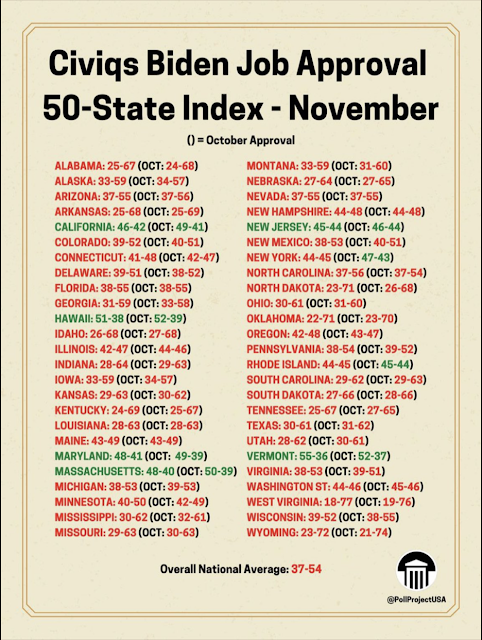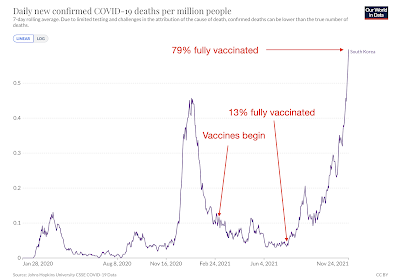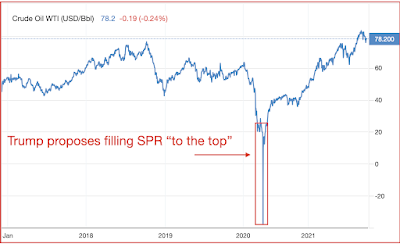A we complete the Thanksgiving weekend here is a compilation of interesting data that might make you go hmmmm.
Consumer Sentiment
Economic activity is largely driven by the attitudes and confidence of people in the marketplace. Are they willing to buy because they are optimistic about the future or are they concerned and become defensive with their money?
Any data about how people "feel" is suspect but I must say that this recent University of Michigan survey on current Consumer Sentiment is concerning.
This is a graph that show consumer sentiment for the purchase of houses, vehicles and large household durables.
The survey ask consumers do you think this is a good time to buy these items?
 |
| Source: https://www.zerohedge.com/markets/umich-sentiment-holds-10-year-lows-inflation-expectations-13-year-high |
My take is that the shock of high inflation for these items has caused increasing number of consumers to say that they are not interested in buying. The costs have become too high compared to their previous concept of value.
Consumer expectations for inflation over the next 12 months is also the highest it has been in 13 years in the University of Michigan survey. That was in 2008 right before the housing market crashed and we entered the Great Recession. You can see how quickly the inflation expectations reversed once the recession took hold.
 |
| Source: https://www.zerohedge.com/markets/umich-sentiment-holds-10-year-lows-inflation-expectations-13-year-high |
People may adjust to the new price levels in time but this may be dependent on wages and employment increasing and easy credit and low interest rates continuing.
Recessions begin due to a combination of factors but loss of confidence by the consumer is at the top of the list.
What lies ahead in 2022?
Biden polls
It can be argued that consumer concerns are also reflected in Joe Biden's current approval ratings.
I looked at several Biden polls this week in some detail that reveal some interesting information.
A Civiqs poll has Biden's approval at 37%. 54% disapprove.
What I found interesting is looking at some of the state numbers.
Consider first off that Biden only has 39% approval in his home state of Delaware.
 |
| Source: https://twitter.com/PollWatch2020/status/1463627609753935872/photo/1 |
The four lowest states for Biden.
West Virginia 18%
Oklahoma 22%
Wyoming 23%
Kentucky 24%
There are only two states that Biden has at least 50% approval.
The four highest states.
Vermont 55%
Hawaii 51%
Maryland 48%
Massachusetts 48%
It is in the swing states that decided the last election that you see Biden's problems most acutely.
Arizona 37%
Georgia 31%
Pennsylvania 38%
Wisconsin 39%
Here are two states that not long ago were considered to be swing states.
Missouri. 29%
Ohio 30%
Is that true any more?
A Marist/NPR poll (traditionally a more D-leaning poll) has Biden with a 42% approval rating.
However, what I found interesting in this poll were the internal demographic splits.
This poll has Biden's approval the lowest with young voters. It is highest with older voters.
This is the complete opposite of standard norms.
For example, only 2% of those 18-40 strongly approve of Biden?
This is where Biden's strongest age group support came in 2020. It is also a group in which the Democrats expect to get 60% of the vote regularly.
On the other hand, Biden is getting his highest approval from older voters. 27% of Baby Boomers (ages 57-75) and 23% of those over age 75 say they strongly approve of Biden.
Only 9% of Gen Xer's (age 41-56) say they strongly approve of Biden.
 |
| Source: https://maristpoll.marist.edu/wp-content/uploads/2021/11/NPR_Marist-Poll_USA-NOS-and-Tables_202111220913-1.pdf |
Interestingly, 55% of young voters say they will stay with a Democrat in the 2022 mid-terms despite their views on Biden.
However, majorities of all other voter age groups say they will vote for the Republican in the congressional races.
 |
| Source: https://maristpoll.marist.edu/wp-content/uploads/2021/11/NPR_Marist-Poll_USA-NOS-and-Tables_202111220913-1.pdf |
How do you explain it?
My take is that younger voters have borne the brunt of Covid policies. Lockdowns, vaccine mandates and all the rest. They are not happy about it, especially after Joe Biden promised he was going to lockdown the virus, not the economy.
They see higher cases and deaths in 2021 than in 2020 with no end in sight.
I am guessing they feel they have been badly misled.
One pollster I follow suggests that Biden's drop in the polls beginning in August had more to do with Covid than Afghanistan. Seeing the extent to which young voters are turning on Biden I have to agree.
Richard Baris has Trump +8 over Biden if an election was held today.
Rasmussen has Trump +13 (45%-32%) vs. Biden right now.
Is this because Trump has gotten more popular?
No.
It is an indication of how Biden has become so unpopular.
Covid Continues to Confound
I have spent the better part of the last two years raising questions about what the "experts" were telling us about Covid.
Covid has confounded me at times as it has everyone. However, I believe I have been correct in my assessments a much higher percentage of the time than have the "experts" who want you to believe they know all the answers.
For example, a month ago the CDC was predicting that Covid cases would continue to decline nationally in November. Undoubtedly, the CDC was putting a lot of confidence in the vaccines to make that projection.
Even the The New York Times admitted this week how wrong those models are turning out to be. (From New York Times This Morning, November 23, 2021).
A month ago, Covid-19 cases had begun to rise in a few parts of New England and the Mountain West. But they were still falling in most northern parts of the U.S., as well as in Canada.
That pattern seemed to suggest that a nationwide cold-weather Covid surge was unlikely anytime soon. The prediction models collected by the C.D.C. agreed: They projected continuing declines in U.S. Covid cases during November.
Instead, cases have surged about 30 percent this month.
It's a maddening development.
It certainly is a maddening development when you told everyone that the vaccines were the passports to freedom, safety and security.
Here is what I wrote after assessing the data I was seeing heading into November.
A big reason the national numbers have come down recently is that there are few big population centers in the Upper Midwest states compared to the Sunbelt.
However, what happens when Covid challenges Chicago, Detroit, Cleveland, Philadelphia and Boston and other large population centers in the coming months?
Based on what I have seen previously, I am not confident the vaccines are up to the task. I hope I am wrong.
Look at the 14-day case increases in the states of the cities I referenced above that I was concerned about but which the CDC was predicting declines in November.
Illinois +50%. (61% of entire population fully vaccinated)
Michigan +88%. (54%)
Ohio +34%. (53%)
Pennsylvania. +43%. (58%)
Massachusetts +77%. (71%)
Two other states that are seeing the highest increase in cases right now are Connecticut (+108%) and Rhode Island (+66%). 72% of every man, woman and child in these state is fully vaccinated. They are tied for second behind Vermont (73%) as the most vaccinated states.
What is astonishing to me is that it has taken so long for The New York Times and others (CDC?) to recognize the strong influence of seasonality on Covid transmission. I was writing about this relationship 18 months ago with the data I was seeing in South America.
Looking at the data from Europe also continues to raise questions about the efficacy of the vaccines and the use of mask mandates, lockdowns and other public health interventions on ending the pandemic.
The European Union currently has more confirmed cases of Covid than they have ever had.
This is with 77% of the age 18+ population and 66% of the total population fully vaccinated this year compared to 0% last year.
Deaths right now are about 1/2 of last year's peak which could be attributable to the vaccines. However, deaths lag cases and both are still rising right now.
Is this anywhere close to what was promised when the vaccine program began?
To be truly confounded look at what is occurring in South Korea right now.
South Korea has been hailed throughout the pandemic as having one of the best public health responses in the world to Covid.
It also has one of the highest vaccination rates in the world.
79% of the total population is fully vaccinated.
How is that working out right now?
Confirmed Covid cases in South Korea.
 |
| Confirmed Covid cases in South Korea |
Covid deaths in South Korea.
 |
| Confirmed Covid deaths in South Korea |
Yes, South Korea is still doing better than most of the world regarding Covid.
Deaths are about half the World rate and one-fifth of the United States right now.
However, put the narrative aside about the vaccines and everything else we hear about Covid and assume you just landed from Mars and were asked to look at all of the data above and assess whether it is working.
What would your conclusion be?
Are we at the point of asking the question as to whether all of the public health interventions have actually made the pandemic last longer and has resulted in more adverse effects than if we had done nothing more than protect the vulnerable?
Strategic Petroleum Reserve
Did you notice what happened to the price of crude oil after Joe Biden announced he was tapping the Strategy Petroleum Reserve in order to lower gas prices?
It immediately rose from around $75.50 to $78.50 per barrel before settling down a little over $78 per barrel.
A major reason for the increase is that oil traders know that the oil will need to be replaced in the SPR and this demand will affect future prices.
President Donald Trump had the foresight to state that he wanted to fill the SPR to the very top at the beginning of the pandemic to take advantage of the low prices of crude oil.
 |
| Source: https://www.marketwatch.com/story/trump-seeks-to-add-75-million-barrels-of-oil-to-strategic-petroleum-reserve-amid-historic-price-crash-2020-04-20 |
 |
| Source: https://www.worldoil.com/news/2020/3/13/trump-to-fill-us-strategic-petroleum-reserve-to-the-very-top |
Congress would not agree to fund that purchase.
They were more focused on appropriating money for ventilators at the time that ending up not being used.
Crude oil was around $20 per barrel in March-April, 2020. The average cost of oil in the SPR right now is $29.70 per barrel.
When Biden's actions are all said and done it is unlikely that the oil release will have any real impact on consumer prices.
We are talking about a release of oil from the SPR equal to 3 days of demand. As I said in my last post, this is akin to spitting in Boston Harbor.
After which, the Strategic Petroleum Reserve will need to replenish its reserves with $70-$80 oil in case of a real emergency due to issues of supply.
All the while no one remembers or mentions that Donald Trump wanted to buy oil at $20 or below.
If you recall, there was even a period in mid-April, 2020 that the price of oil went negative because there was no place to store it. Oil producers were actually paying purchasers to take the product.
There was one place that had storage capacity---the Strategic Petroleum Reserve.
 |
| Source: https://tradingeconomics.com/commodity/crude-oil |
There are a lot of things that make you go hmmmm these days!





No comments:
Post a Comment